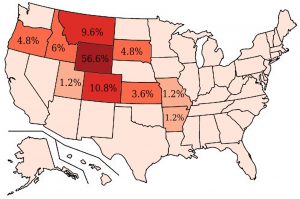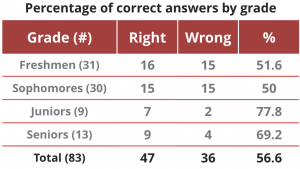Do UWO students know where Wyoming is?
November 11, 2020
Do UW Oshkosh students know where Wyoming is? I could not tell you what made me want to know the answer to this question, nor why I thought the answer would be of any value to literally anybody, but I felt that it needed to be answered.
To find out if UWO students could find the great state of Wyoming, I conducted an abhorrently unscientific survey. For the survey, students around the UWO campus were presented a blank map of the United States and simply asked to point at which state they thought was Wyoming.
In the end, 83 students gave their best shot at locating Wyoming, and only 47 were able to correctly identify its whereabouts.

In other words, just over half, or 56.6%, of the surveyed students successfully answered the question.
In all honesty, this was a lot better than I expected but still disappointing.
During the interviews, it was evident that everyone immediately knew to look toward the Western U.S, but that is where the struggles began.
The states most commonly misidentified as Wyoming were Colorado and Montana, which made up 10.8 and 9.6% of the overall guesses each. In all fairness, these guesses were not too far off. Most of the other wrong guesses were also for states that are very close to Wyoming.
Idaho made up 6%, Oregon and South Dakota made up 4.8% each, Kansas made up 3.6% and Utah made up 1.2%.
In terms of answers that were significantly further off, Missouri and Arkansas each got one vote.
Also worth noting, the sophomore who guessed Arkansas started off their answer with “I know it has to be somewhere on the East coast” before guessing one of the most central states in the contiguous U.S.
When doing the survey, the grade of the participants was also tracked, allowing for some further “analysis.”
The vast majority of the respondents (73.5%) were either freshmen or sophomores, which can be explained by the fact that they are more likely to be on campus, where the surveying was done.
The freshmen and sophomores each had an almost perfect split between right and wrong, with 51.6% of freshmen finding Wyoming and 50% of sophomores doing the same.
The upperclassmen performed much better, with juniors being right 77.8% of the time and seniors being right 69.2% of the time, but the lower sample sizes of this group do mean these results could be very skewed.
I suspect that if I did have a larger sample of upperclassmen, the percentage of those who correctly identify Wyoming would be closer to 53-60%, based on the law of large numbers.
In addition to interviewing UWO students, I also got a small sample of elementary school students to answer the same question as a point of reference.
 In the sample of elementary school students, which was made up of third and fourth
In the sample of elementary school students, which was made up of third and fourth
graders, only one out the 25 students was able to find Wyoming.
That means only 4% of the elementary schoolers were only able to find Wyoming compared to 56.6% of UWO students.
Needless to say, this doesn’t really prove anything, but at least we have some indication that the education system isn’t a complete failure.
Unfortunately for the UWO students who picked Arkansas and Missouri, they were in a like mind with the 8- and 9-year-olds, who also often misidentified Wyoming as one of those two states.
While this study lacked nearly every element of a legitimate study, the results aren’t too far off the results of more professional surveys.
A 2006 National Geographic study on geographic literacy among Americans ages 18-24 presented participants with a map of the U.S. and had them try to identify seven states. The study found that, while the likes of Texas and California were correctly identified 92% of the time, the likes of Ohio and New York were only guessed correctly 43% and 50% of the time, respectively.
In that study, it is also noted that participants with college experience were more likely to identify all of the given states, which, for the purposes of my survey, would help explain why the success rate is comparatively high for finding a less popular state like Wyoming.
Another reason why the UWO numbers could be higher is that the surveying was done the week after the election, meaning that a good chunk of students had spent time examining a map of the U.S. at some point within the last week.
That being said, the fact that 43.4% of the UWO students could not identify one of their own 50 states is not exactly something to celebrate.
Sure, this survey may not have been the most conclusive study ever done, but I think it helps give some insight into just how geographically illiterate we are as a country.
The fact that U.S. citizens not only rank very poorly among citizens of other developed nations in identifying countries of the world but are also poor at finding the states in their own country, is kind of disappointing.
I really wanted to end this piece on a high note, but to be completely honest, I’m not sure there is one.













